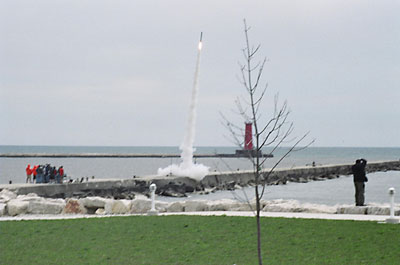The bombardment of Sheboyganby Eric R. Hedman
|
| When I was a boy I played with small Estes rocket kits launching small payloads a few hundred feet in the air. The rockets launched in this program are in some ways similar, but much bigger and more powerful. |
In this year’s event 46 high school teams from Wisconsin and surrounding states entered. It wasn’t just a contest to build a rocket and fire them off. Each team had to prepare a presentation on how they built their rocket and design an experiment to be flown on board. The presentations included displays that documented the construction of the rockets and explained the experiments. The experiments included altimeters to measure how fast and how high the rockets could reach and ways to package and cushion raw eggs to survive the acceleration among others.
I didn’t know what to expect when I arrived at the event. Just outside of the conference center was a NASA bus with a traveling theater inside. Inside the conference center or “mission control” were booths from several organizations that ranged from Estes Rockets to NASA. Attendees had a chance to learn about rocketry as a hobby and also a look at future careers those interested in math and science could have.
Rockets for Schools is an interesting collaboration with a number of organizations helping out. The Civil Air Patrol sets up a command center to make sure launches only happen when the airspace is clear. The US Coast Guard provides the rocket recovery service with their small patrol boat. The local fire department is on hand just in case of a problem. Randy and Carol Lutz organize the event. Teachers at the high schools involved help guide the students and teach them how to put together and present their projects.
NASA had a booth inside the conference center. While I was listening, the people manning the booth were explaining to a high school student and his parents the path he could follow for a NASA career. They were honest about the facts that future employment opportunities with the agency are uncertain.
Parked outside of the conference center was the NASA bus from the Glenn Research Center in Ohio. Inside of the aging bus was a little theatre with a large flat screen TV to show PR videos. I watched a video animation of the Spirit and Opportunity rovers moving across the surface of Mars. The outside of the bus is covered with images of several NASA projects. Unfortunately, many of the images are of projects canceled before completion.
For those with an interest that goes a bit more into hard core engineering there was a booth from ORBITEC (Orbital Technologies Corporation) out of Madison, Wisconsin. They had a sample of the lunar soil simulant that they have developed for NASA. The simulant is designed to help figure out how to develop the equipment to be used exploring the surface of the Moon. They also had material showing how their innovative vortex hybrid rocket engine works.
| When NASA and much of US industry complain about the lack of people going into technical fields, these are the kinds of programs they need to support. |
The main feature of the event, of course, was the launch of the rockets and their payload experiments. Launching was getting under way when I first arrived, although the day was less than ideal. The winds were high and blowing off the lake towards downtown Sheboygan. The launch pad for the rockets was a pier sticking out into the harbor behind the conference center. I witnessed the first three launches. It is amazing how fast these large high powered rockets raced up to the cloud cover. Each of the first three rockets was caught in the 65 km/h winds aloft and thus successively blown farther inland before landing. One landed well over a kilometer inland. This led to a temporary suspension of launches to prevent a bombardment of Sheboygan by scores of rockets coming down under parachutes. The launches were later resumed after the launch pad was moved farther out on the pier and the winds eased up a bit.
The launching isn’t just for high school students. A couple of adult teams launched their rockets at the event. There aren’t too many events where these teams are allowed to fire rockets that can reach an altitude where aircraft may be flying. Jason Turicik and David Jark showed me their half-scale model of a Patriot missile. Not wanting to give up the hobby they started as kids, they build and launch high performance rockets. The engine has a peak thrust of approximately 3,300 newtons. The rocket reaches a speed in excess of 800 km/h.
Rockets for Schools has a wide variety of sponsors, from the Green Bay Packers and the Milwaukee Brewers to the 11th Bomb Squadron from Barksdale Air Force Base in Louisiana, as well as several businesses and foundations in Wisconsin. The support is an acknowledgement of the importance of supporting programs that encourage students to pursue interests that require math and science to succeed. Rockets for Schools is an outstanding program for high school students. It gives young people an idea of what studying math and science can lead to and how it’s applied. The requirement to put a presentation together and explain what they are doing helps enhance the learning experience. When NASA and much of US industry complain about the lack of people going into technical fields, these are the kinds of programs they need to support. It encourages and inspires the students so that they’ll want careers in science and engineering. If you have a chance, catch next year’s event. If your child’s high school would like to take part, contact them at rockets4schools.org.
